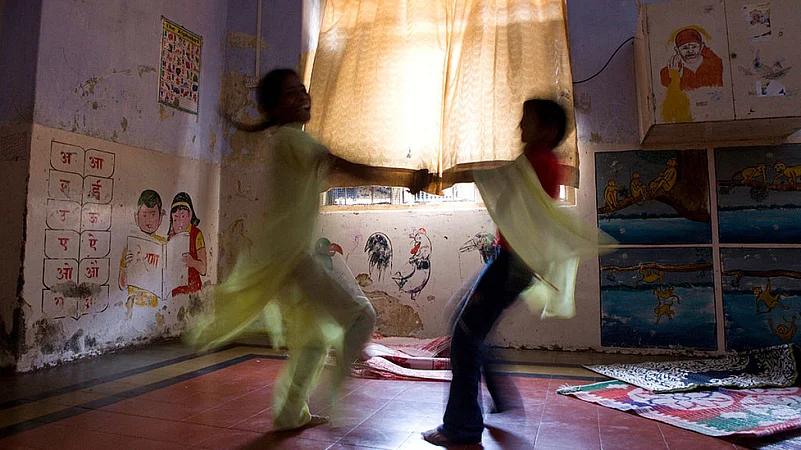NGO Prerana is rehabilitating Kamathipura's sex workers by educating them about their rights against the backdrop of displacement and ensuring their children get good education against all odds.
For nearly four decades, Priti Patkar has been working with trafficked women in the sex trade and their children in Mumbai's red-light area, Kamathipura. One image that remains etched in her memory, is that of a child, barely a few years old, sleeping on the lower bunk bed, while her mother “services a client” on the birth. “When I asked how the child was fast asleep, they said she was fed something to remain sleeping so she won't bother her mother while she's at work,” she says.
In 1986, Patkar established Prerana, a Mumbai-based NGO, to eliminate “intergenerational prostitution” by protecting women and children from the threat of human trafficking. The organization started the first Night Care Center (NCC) to protect children in the evenings when they have to fend for themselves while their mothers pay undivided attention to the customers.
As a profession, prostitution is usually generational, passed down from one generation of women in the family to another, through the ages. As soon as a girl would turn 12-13, she starts being groomed for the job. Patkar recalls an instance where a girl, her mother and grandmother, all three were dressed up and made to stand out on the streets by their pimps to attract clients. “That image has stayed with me,” she says.
The boys are also roped into the business of sex trade. “We have seen young boys being trained to become pimps or inducted into the allied activities of the sex trade. Slightly older boys would sometimes transport VCRs and DVDs because a client might have asked to watch a blue film with one of the sex workers,” says Patkar.
Over the years, however, these women, thanks to the civil society organizations like NGO Prerana, have learned their rights, and discovered the possibility of a better future for their children. These organizations like Prerana work closely with Kamathipura's sex workers to show them it was possible for their children to break out of the vicious cycle, get educated and have a different future. “When we started enrolling their children into schools, the mothers realized that we wanted to help and support them, and will not leave,” recalls Patkar.
The most accessible school for the sex workers' children was a municipal school located within Kamathipura. “Over 20 years back, the school's total population was over 3,000, and not even one percent consisted of the children from the red-light area,” she says. But after NGO Prerana's intervention, these mothers who were unsure of their children's future prospects now want their children to attend school at any cost. Patkar explains that the municipal school would admit children once they would turn six, and because most of the children of sex workers did not have a birth certificate, the way to measure their age was “to ask them to hold their left ear with their right hand from over their head”. If they could, they would be admitted.
“Almost all of sex workers' children in Kamathipura are attending school. They are in Classes 10, 12, completing graduation, making their own choices, which the women never thought would be a reality for their children.” Patkar recalls an 11-year-old daughter of a sex worker who emancipated herself after overhearing the brothel owner offer her mother a hefty sum to rope her into the sex trade. “The girl confided in our workers that she didn't feel safe to go back. So, we took her to the Child Welfare Committee that in turn placed her in a children's home.”

As Kamathipura prepares for redevelopment and subsequent displacement, it raises concerns over the employment prospects of sex workers and their children's education. Patkar says many women have already moved out of the brothels. However, this doesn't mean they have cut off ties. “Over the last 15 years, many of these women living the suburbs, but still controlled by their pimps, come to Kamathipura in the evenings, and take an early morning train back home,” she says. Many brothel keepers in Kamathipura, Patkar says, manage establishments across other red-light areas in Mumbai. “So, during the redevelopment, brothel keepers might shift these women to these establishments in other localities,” she says.
On the plus side, the sex workers and their children have learned to fight for the right to education. “When the women move out of the red-light area, they ensure their children don't drop out from school. NGOs like us help mothers and children to fight against all odds. They reach out and seek our help to get the children admitted to a local school and continue their education.”
To ensure that the children of sex workers do not get pushed back into vulnerability again, Patkar says, they must be provided with reliable information and the government needs to listen to the sex their questions, suggestions and concerns, over the redevelopment. Armed with reliable information, there are fewer chances of getting duped. “Some sex workers believe they would be compensated in the redevelopment plan, and are already paying lawyers. They keep borrowing and paying back, and get trapped in a cycle of debt. Someone needs to tell them about their rights and claims in the redevelopment plan, and if they are even eligible for compensation,” notes Patkar.
The best solution, feels Patkar, is a one-stop assistance center for sex workers, where experts in different fields can enlighten them about their rights, and help them about any other queries. “Someone might require legal advice, economic rehabilitation, and livelihood training to get a job. Another woman might need support with healthcare or education. This assistance center should have legal experts and other professionals who can guide them on the choices they want to make,” concludes Patkar.
















